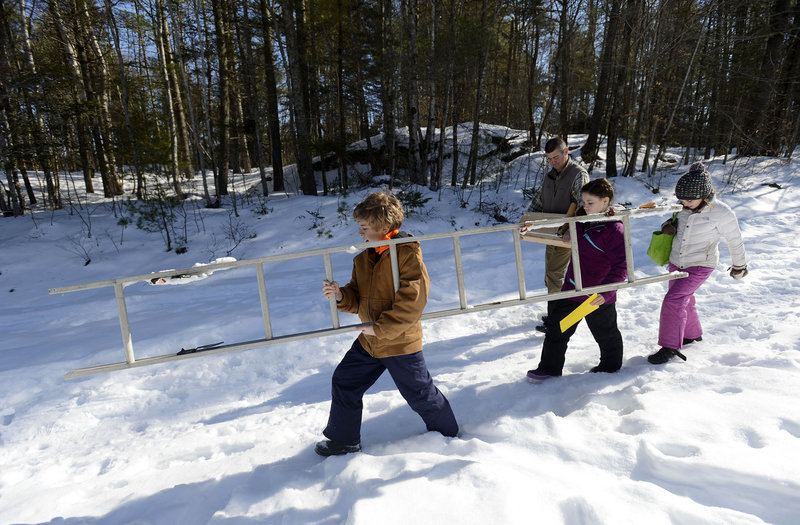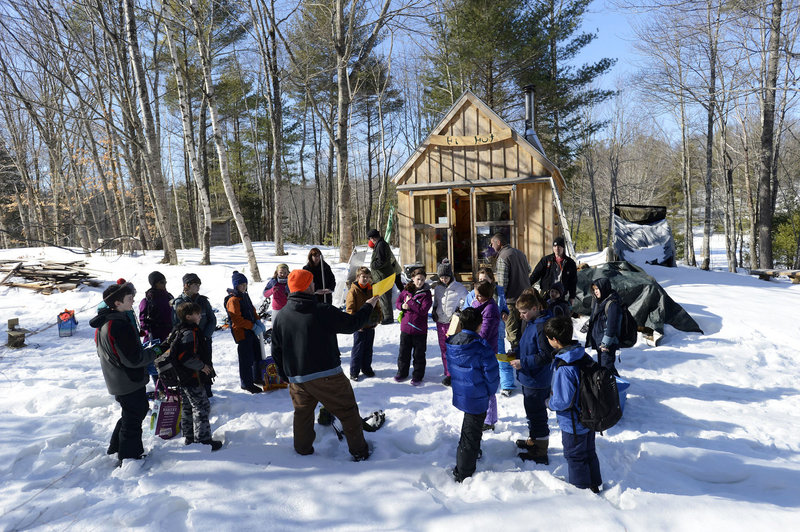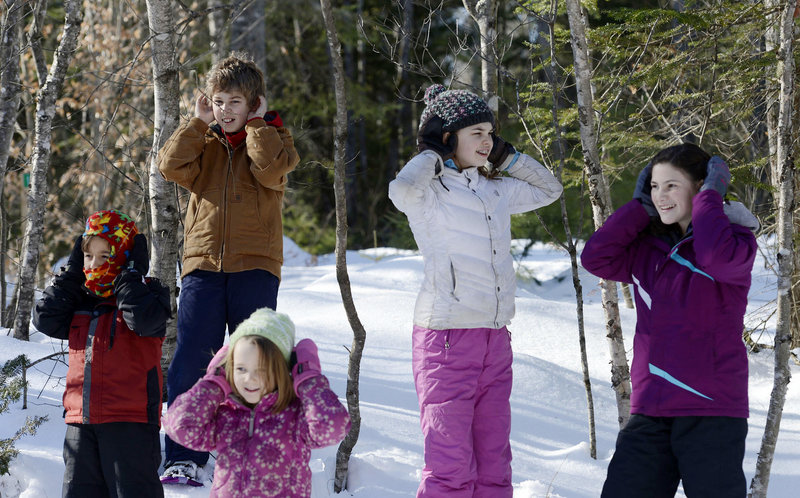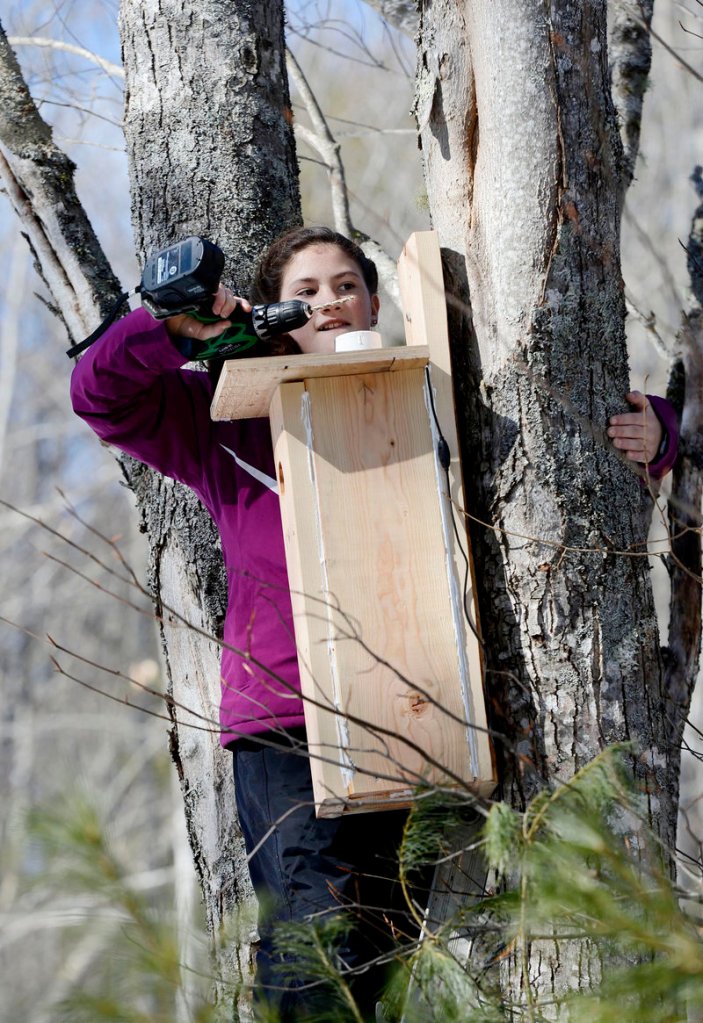JEFFERSON — A dozen fifth- and sixth-graders spread out across the snow. And looking like a yoga class in the middle of nowhere, they stretched out their hands, got down on their hands and knees, and cupped their ears as if in a primitive ritual.
Welcome to Edgecomb teacher Glenn Powers’ class, “40 Days in the Maine Woods.”
Richard Louv’s got nothing on Powers.
But the author of the best-seller “Last Child in the Woods” would surely give a nod to the Edgecomb teacher who this year created an entire grade-school science class set in the woods.
Each week, the children in Powers’ class at The Center for Teaching and Learning travel a half-hour to Hidden Valley Nature Center for wildlife lessons followed by hands-on scientific research they collect for organizations looking for wildlife inventory data collected by citizen scientists.
Two weeks ago on a mild winter day, the students stood in the snow displaying to the best of their ability the keen senses of owls, deer and coyote. The barred owls’ remarkable vision, the coyotes’ sense of smell and the whitetail’s hearing were explained to the students in exercises that had them act out each animal’s unique attribute.
“When you focus on all these things at once in the forest, a new world will open up to you. You’ll notice more things and become a master tracker,” Powers told them.
Then the data collection began and they went off in different directions to thread a camera into a beaver den, hang nesting boxes for four bird species, and check their brush piles for signs of small critters.
The active, gym-class-like format and the scientific experiments kept the students not only on task, but silent like black bears.
But this is what Louv promised in his groundbreaking book that demanded educators incorporate the natural world into their course work: “Nature inspires creativity in a child by demanding visualization and the full use of the senses,” Louv wrote. “In nature, a child finds freedom, fantasy and privacy: a place distant from the adult world, a separate peace.”
At The Center for Teaching and Learning in Edgecomb, Powers has embraced these concepts whole-heartedly in his 40-day class. Of course, Powers has some flexibility at The Center, an independent school founded in 1990.
The school is accredited by the state and the New England Association of Schools and Colleges, but it brings a focus on original, hands-on work that includes research and experiments, as well as data collection and analysis.
“The goal is to come to the woods, do the activity and collect data. We are full-bore doing science. They’re not just being given facts, they are learning everything about doing the science that gives us the facts. Their bird ID skills are phenomenal; their tracking skills are good,” Powers said.
With so many critters across Maine’s landscape being studied by a multitude of wildlife biologists and scientists, the opportunity for meaningful wildlife studies by students is limitless.
With this in mind, Powers reached out to a half-dozen wildlife experts and asked what data his students could collect. The class now has a half-dozen studies in which they collect real data to turn over to scientists and biologists in Maine, such as coyote howling recordings, salamander counts, bird counts, bird-nesting box counts and tree species identification.
Pat Maloney in Augusta is delighted to see a new school group sign up to collect forest inventory data. At the Maine Tree Foundation, Maloney coordinates the state’s Project Learning Tree curriculum with the forest growth data the state needs.
In 10 years, Maloney has seen her program take hold in classrooms in Auburn, Topsham, Machias, Jay and Newport, where teachers take students out to gather tree species information, and measure the health and diameter of trees.
But for the most part, the Forest Inventory Growth project has been a tough sell, Maloney said.
“We need to redesign it, expand the type of data kids are collecting and put a few things on the website to make it easier for students once they enter the data to compare it and create Excel sheets. One of the things I’ve learned in this job is you have to be patient,” she said.
Likewise, Evan Adams at the Biodiversity Research Institute in Gorham also is wondering how well the fifth- and sixth-graders will add to the data he gathers in southern Maine at nest boxes. But he’s delighted they’re involved.
“The goal is for them to contribute real data. It’s a checklist. They just look and see, is anybody in the nest box, and what (kind of bird) and how many eggs are there. Absolutely we will use that data,” Adams said. “We do take classes out. We don’t have a class like Glenn’s who are independently gathering data themselves.”
However, bat conservationist Annie Kassler in the midcoast has some idea how the students will fare. She gave a presentation on bats to them and saw the seeds of inspiration already taking hold.
Kassler, a presenter with Bat Conservation International in Texas, said when she spoke to Powers’ class, the students’ understanding of bats surprised her.
“For me it’s not so much about collecting data as it is to get kids fascinated in bats. They all seemed to be quite fascinated and had stories. I was impressed with how much they knew. And they knew the issues concerning bats,” Kassler said.
Staff Writer Deirdre Fleming can be contacted at 791-6452 or at:
dfleming@pressherald.com
Twitter: Flemingpph
Send questions/comments to the editors.








Success. Please wait for the page to reload. If the page does not reload within 5 seconds, please refresh the page.
Enter your email and password to access comments.
Hi, to comment on stories you must . This profile is in addition to your subscription and website login.
Already have a commenting profile? .
Invalid username/password.
Please check your email to confirm and complete your registration.
Only subscribers are eligible to post comments. Please subscribe or login first for digital access. Here’s why.
Use the form below to reset your password. When you've submitted your account email, we will send an email with a reset code.